Research Impact Resources
Welcome to the Research Impact Resources for Technological University Dublin. This page supports our academic community to understand, achieve, and evidence the impact of their research. You will find practical tools and guidance spanning the full pathway from early planning and stakeholder engagement through to evaluation and communication of outcomes. Our aim is to help you maximise the academic, societal, environmental, cultural, and economic value of TU Dublin research.
TU Dublin Research Impact Framework
Unlock the full potential of your projects with our Research Impact Framework. Use it to plan for impact in grant applications, track progress during delivery, and communicate results at key moments. Access the PDF by clicking here, or watch the short video introduction below. An audio narration of the framework is also available here.
Citation
Technological University Dublin. (2025). Technological University Dublin Research Impact Framework (Version 1.0.2). https://doi.org/10.5281/zenodo.14235274
Downloads (expand to view items)
+ Framework & Strategy Documents
- TU Dublin Research Impact Framework (PDF)
- TU Dublin Research & Innovation Strategy 2023–2028 (PDF)
- TU Dublin Startegic Intent 2030 (PDF)
- TU Dublin Strategic Plan 2024-2028 (PDF)
- UN Sustainable Development Goals: indicators list
Training: “Planning for Impact” — video. See booking links below.
+ Templates & Checklists
Training: “Evaluating and Measuring Impact” — clinic support available.
+ Guides & Examples
- Impact Planning Quick Guide
- Collecting consented testimonials
- Attribution and contribution guidance
- Sample TU Dublin impact case studies
Training: “Communicating Research Impact” — video.
+ Webinars & Short Videos
Get support!
- Research Engagement & Impact Office: engagementandimpact@tudublin.ie
- Research Impact Lead: gordon.cooke@tudublin.ie
- Book a one-to-one session
- Weekly online drop-in clinic: Every Friday 2-3pm, from October 3rd
1. Understanding research impact
Public funders increasingly require clear evidence of value for money for taxpayers. Universities are therefore asked to demonstrate the benefits of funded research for people, policy, the economy, culture, and the environment.
TU Dublin defines research impact as:
…the contribution that research makes to society, the environment, the economy, industry, culture, public policy and services, health and quality of life, and collaborations to achieve these.

- Small scale – Local and specific improvements, for example new lab techniques, internal software, or enhancements to teaching practice.
- Medium scale – Regional or sectoral benefits, for example community health programmes, digital infrastructure pilots, or regional skills initiatives.
- Large scale – National or international effects, for example contributions to global health guidance, policy reform, or standards adopted across multiple countries.
Taken together, these levels show how impact can progress from local change to wider adoption when activities are planned, evidenced, and communicated.
2. Impact planning for grants
Impact is easier to achieve and evidence when it is planned early, monitored during delivery, and communicated at the right moments. Every project should set out an Impact Pathway Plan. A practical way to do this is to use the W. K. Kellogg Foundation’s basic logic model.
- Inputs – Time, funding, expertise, infrastructure, data, partners.
- Activities – Research, engagement, training, co-design workshops, prototypes, pilots.
- Outputs – Tangible products and services, for example publications, datasets, software, training materials, workshops delivered.
- Outcomes – Changes in knowledge, skills, behaviours, or practice in the near to medium term.
- Impact – Longer-term change in systems or conditions, for example policy adoption, organisational practice, health or environmental improvements.
Your intended results (outputs, outcomes, impact) can be influenced by the team to varying degrees.
When drafting your pathway, also note the assumptions that must hold, the risks to manage, your stakeholders and their roles, and the indicators and data sources you will use to track progress.
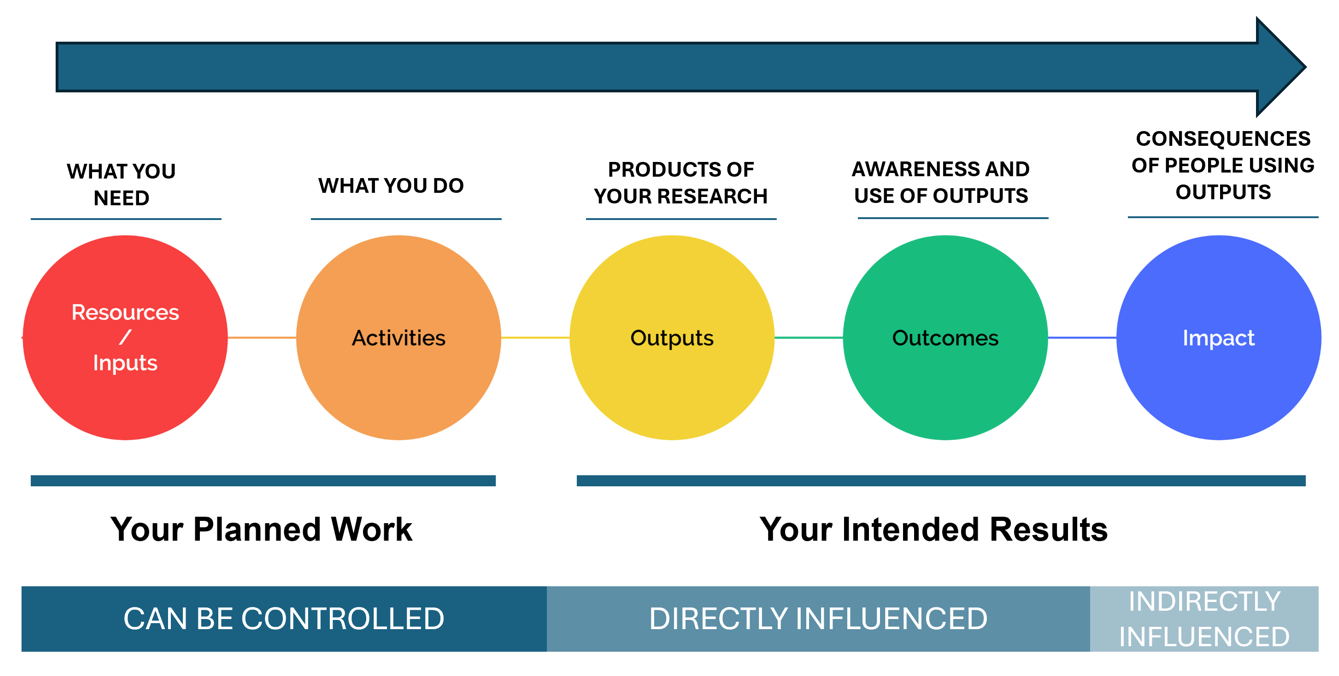
3. Resources and tools
- IUA Researcher Impact Framework – Guide (PDF) This national guide outlines a structured way for researchers in Ireland to plan, assess, and communicate impact across domains.
- SFI Impact webinar slides (PDF) Key concepts, methods, and examples for measuring and communicating research impact in practice.
- IUA Engaged Research: Planning for Impact (PDF) A step-by-step approach to planning engagement activities that enable impact.
- Impact 2030: Ireland’s Research and Innovation Strategy National policy context for maximising the benefits of research and innovation.
- W. K. Kellogg Foundation Logic Model Development Guide (PDF) Comprehensive reference for planning, implementation, and evaluation using logic models.
- TU Dublin: Planning for Impact template. Project pathway template adapted from the Kellogg model. Use it to outline inputs, activities, outputs, outcomes, and impact.
- TU Dublin: Research Impact Case Study template Structured document for drafting and evidencing impact case studies.
- UN Sustainable Development Goals: indicators list Official indicator set for linking research outcomes to SDG targets and indicators.
- Government departments: research interests and strategic priorities (Excel) Summary of Irish Government departments’ stated priorities and research interests to aid alignment and collaboration. Updated monthly. Last updated 4 November.
1. Pathways to impact
Pathways show how your research activities lead to outputs, outcomes, and ultimately impact. They are seldom perfectly linear: feedback loops, stakeholder engagement, and enabling conditions often mediate progress.
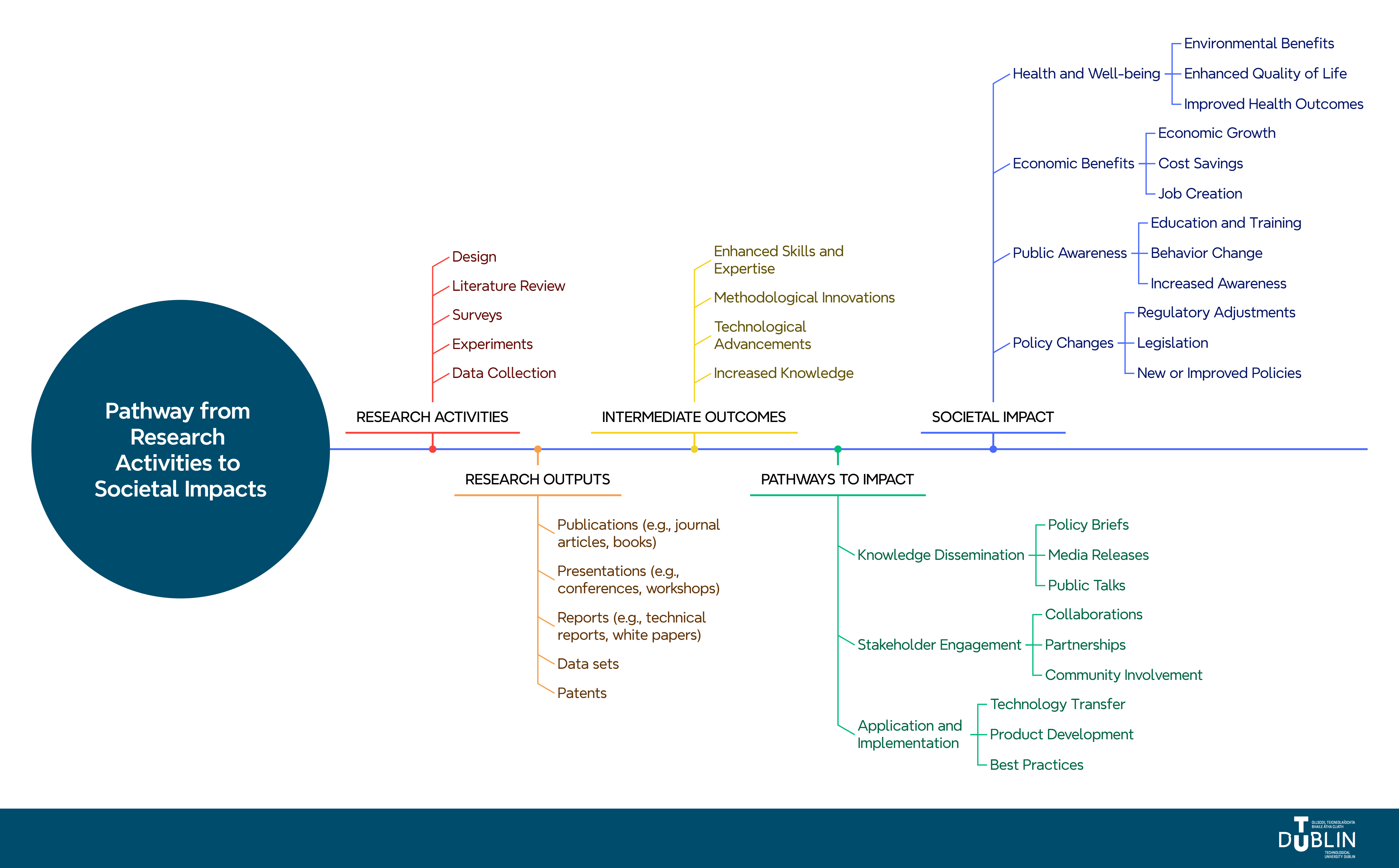
- Plan early – identify assumptions, risks, stakeholders, and indicators.
- Engage purposefully – match audiences and channels to the change you seek.
- Capture evidence – record outcomes as they emerge; do not wait for project end.
2. Example timelines for achieving societal impact
Different kinds of impact mature over different timeframes. The chart below offers indicative horizons; your context, partnerships, and scale of adoption will influence pace
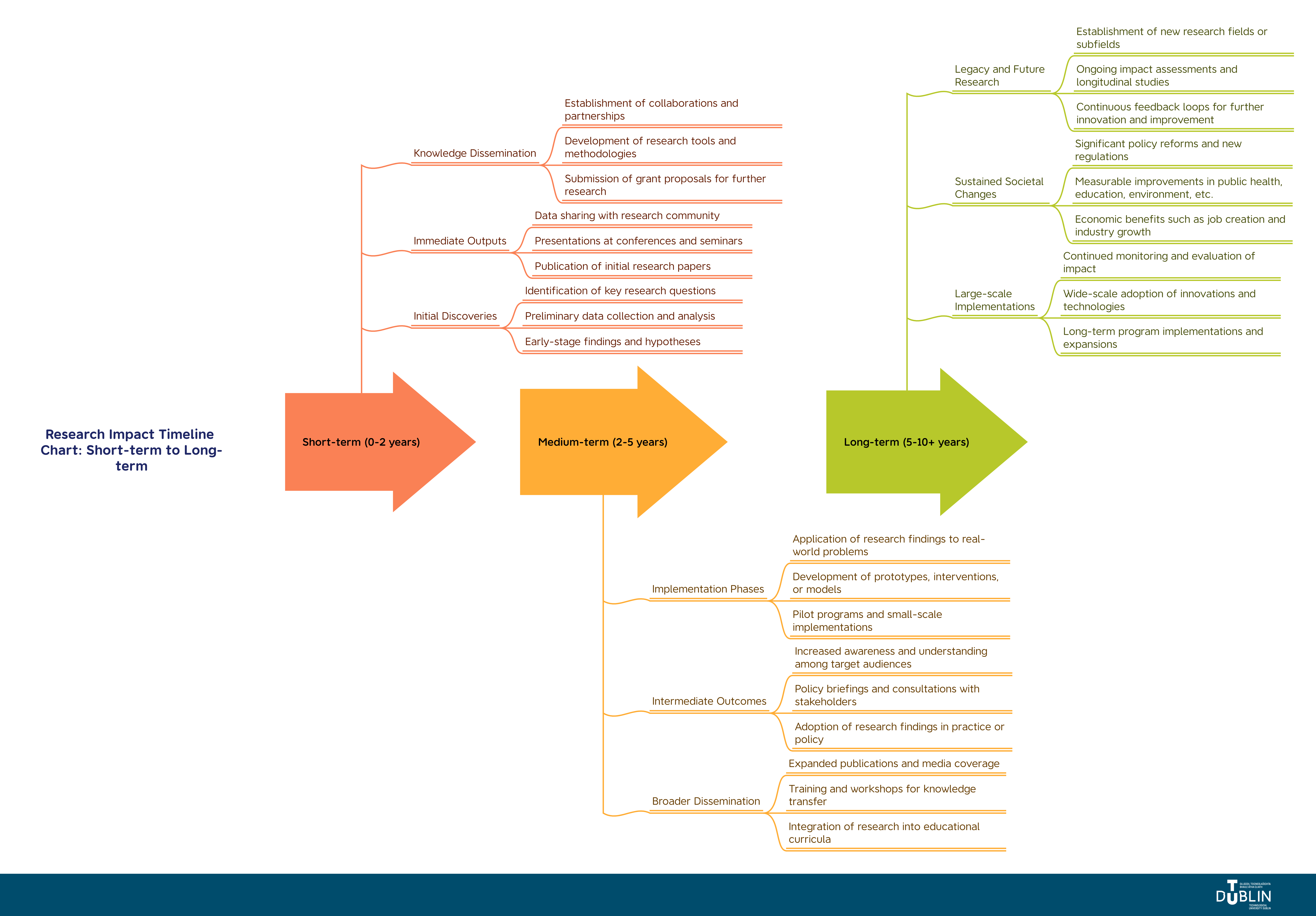
- Short-term (0–2 years) – Initial discoveries, preliminary findings, open datasets, early training materials, new partnerships.
- Medium-term (2–5 years) – Pilots and prototypes adopted in practice, skills uplift in partner organisations, guidance cited, policy drafts influenced.
- Long-term (5–10+ years) – Sustained improvements to health, environment, or productivity; policy or standards implemented at scale; durable behaviour change.
Tip: align outputs to the next step on the pathway (for example prototype → pilot → scaled service) and specify evidence you will collect at each step.
3. Scale and reach of research impact
Impact can occur at multiple levels simultaneously. Clarifying intended scale and reach helps you choose appropriate partners, channels, and indicators.
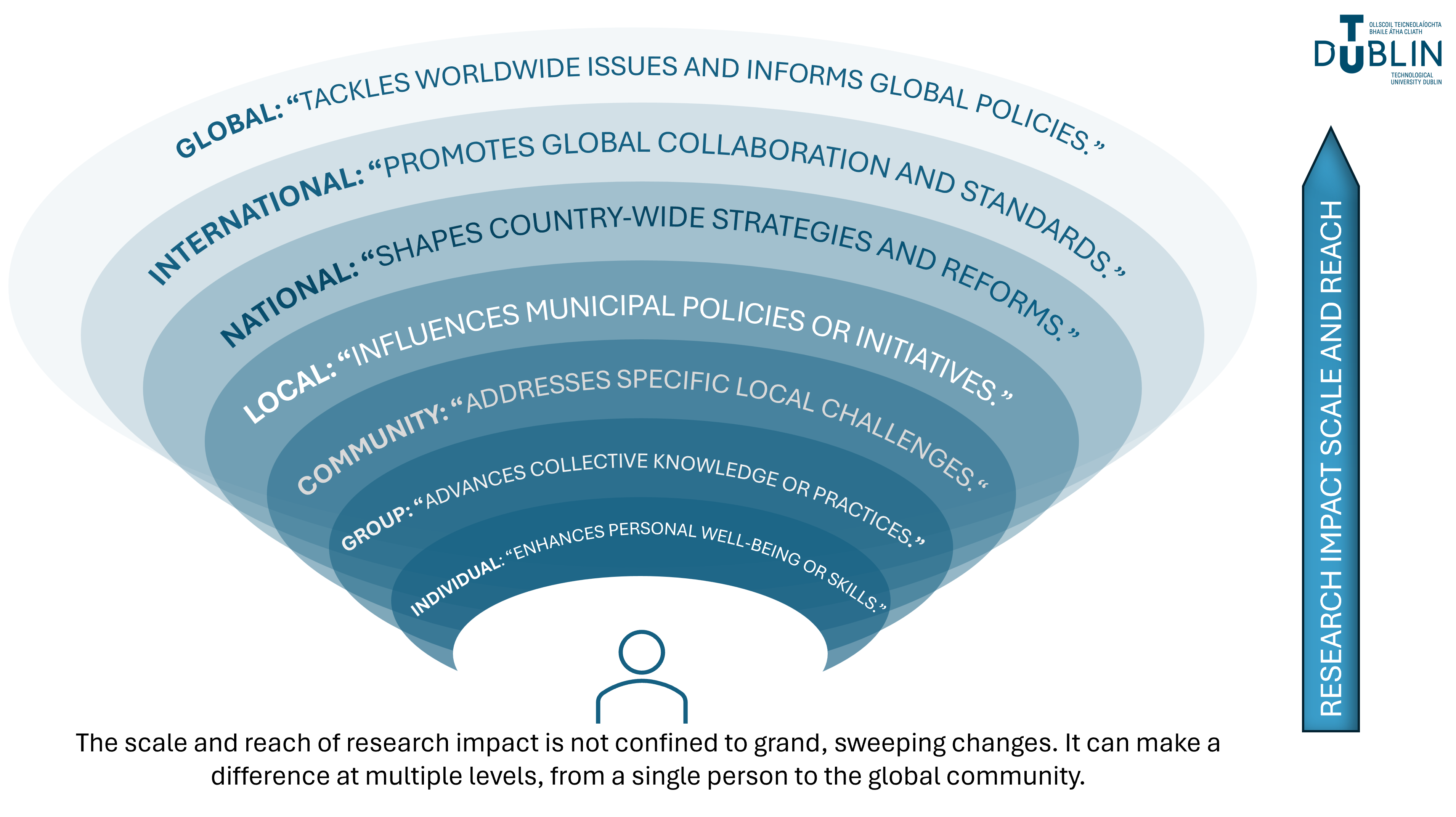
- Individual – Skills or wellbeing gains; evidence may include pre/post measures or testimonials.
- Group or team – Practice changes within a cohort or organisation; track adoption and process improvements.
- Community – Local benefits for defined groups; use community metrics and consented stories.
- Local or regional – Municipal or regional policy and services; cite implementation data and service KPIs.
- National – Strategies, guidance, or curricula; reference official publications and monitoring data.
- International – Cross-border collaboration or standards; include endorsements and cross-jurisdictional uptake.
- Global – Contributions to global norms or targets; align with recognised indicator sets (for example SDGs).
Communicating research for societal impact
Many research outputs are underused or unseen outside academia as widely discussed in the literature. Clear, audience-centred communication, supported by credible evidence, increases the likelihood of uptake and real-world benefit. The resources below help you present your work for different decision-makers and contexts.
1. Writing impact case studies
Impact case studies show how research contributes to change in policy, practice, industry, culture, health, or the environment. They trace the pathway from activities and outputs to outcomes and impact, with evidence at each step. See recent TU Dublin examples on the Research and Innovation impact pages.
- Purpose: document credible change and your contribution to it.
- Audience: funders, partners, policy actors, industry, public stakeholders.
- Length: typically 600–1,000 words plus visuals and links.
- Structure: context and need; research and partnerships; activities and outputs; outcomes and evidence; who benefited; significance and reach; next steps.
- Evidence: quantitative indicators, independent testimonials, adoption data, policy citations, usage analytics, media coverage.
- Attribution: explain your contribution alongside collaborators; avoid over-claiming.
- Accessibility: plain English, clear headings, descriptive alt text, readable tables, accessible PDFs.
Download the Template for Research Impact Case Study (DOCX)
2. Writing policy briefs
Policy briefs summarise actionable insights for policymakers and practitioners. Use them when your findings can inform a decision, programme, or standard within a defined timeframe. The EU has released a new guide on creating policy briefs which you can download from here: Sharing scientific evidence with policymakers.
- Length: two pages maximum, with a one-page summary if possible.
- Structure: title; audience and purpose; key messages; what the evidence shows; options and recommendations; implementation considerations; references and contact.
- Style: neutral, non-technical language; short paragraphs; informative headings; charts with clear labels and sources.
- Quality control: internal factual check; stakeholder sensitivity review; approvals and version control noted on the brief.
- Timing: align with consultations, committee cycles, or budget windows.
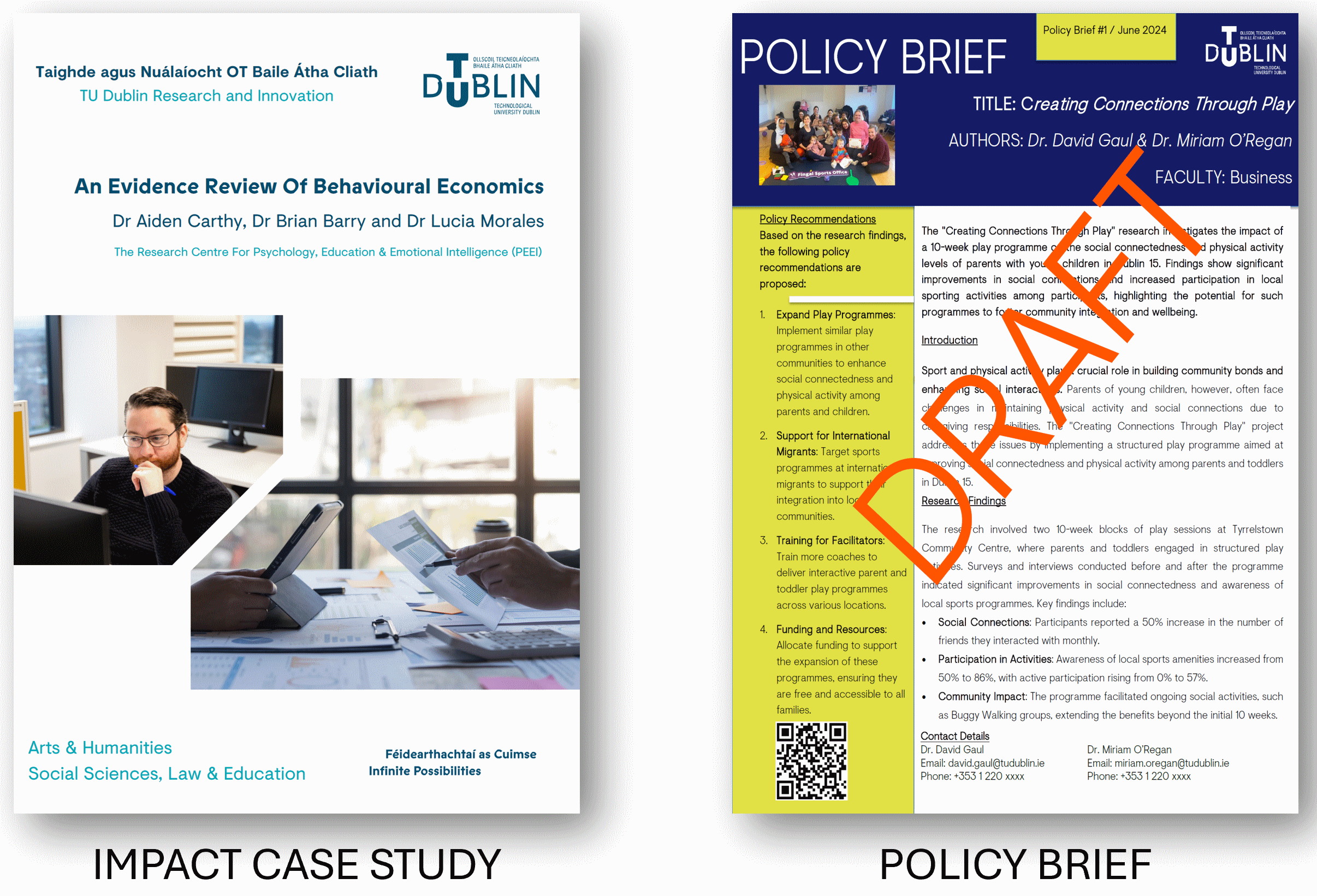
3. News and social media
News items and social posts help the right audiences discover and understand your work. Keep messages focused on the value to others, and link to authoritative sources.
- R&I news: submit stories via the TU Dublin R&I news form and email supporting information to researchandinnovation@tudublin.ie. Published items appear on the Research and Innovation news site.
- What to include: the problem addressed; who benefits; what changes; where to find more detail (for example DOI, dataset, preprint, video).
- Social tips: use plain English; include a single clear call to action; add an accessible image with alt text; tag relevant partners and TU Dublin accounts; link to a persistent source.
- Measure: track referral clicks, downloads, and sign-ups; capture any enquiries or partnership leads generated.
4. Using visuals and infographics
Visuals can make complex results easier to understand, provided they remain accurate and accessible.
- Design: one message per graphic; clear hierarchy; meaningful titles; label units and sources; avoid decorative clutter.
- Accessibility: strong colour contrast; do not rely on colour alone; provide alt text and a short data note; offer a text-only summary where appropriate.
- Formats: export a web-optimised PNG for pages and a high-resolution PDF or SVG for print or reuse.
- Tools: create quick visuals with Adobe Express. Example mock-up: download sample infographic.
Five progressive levels of research impact
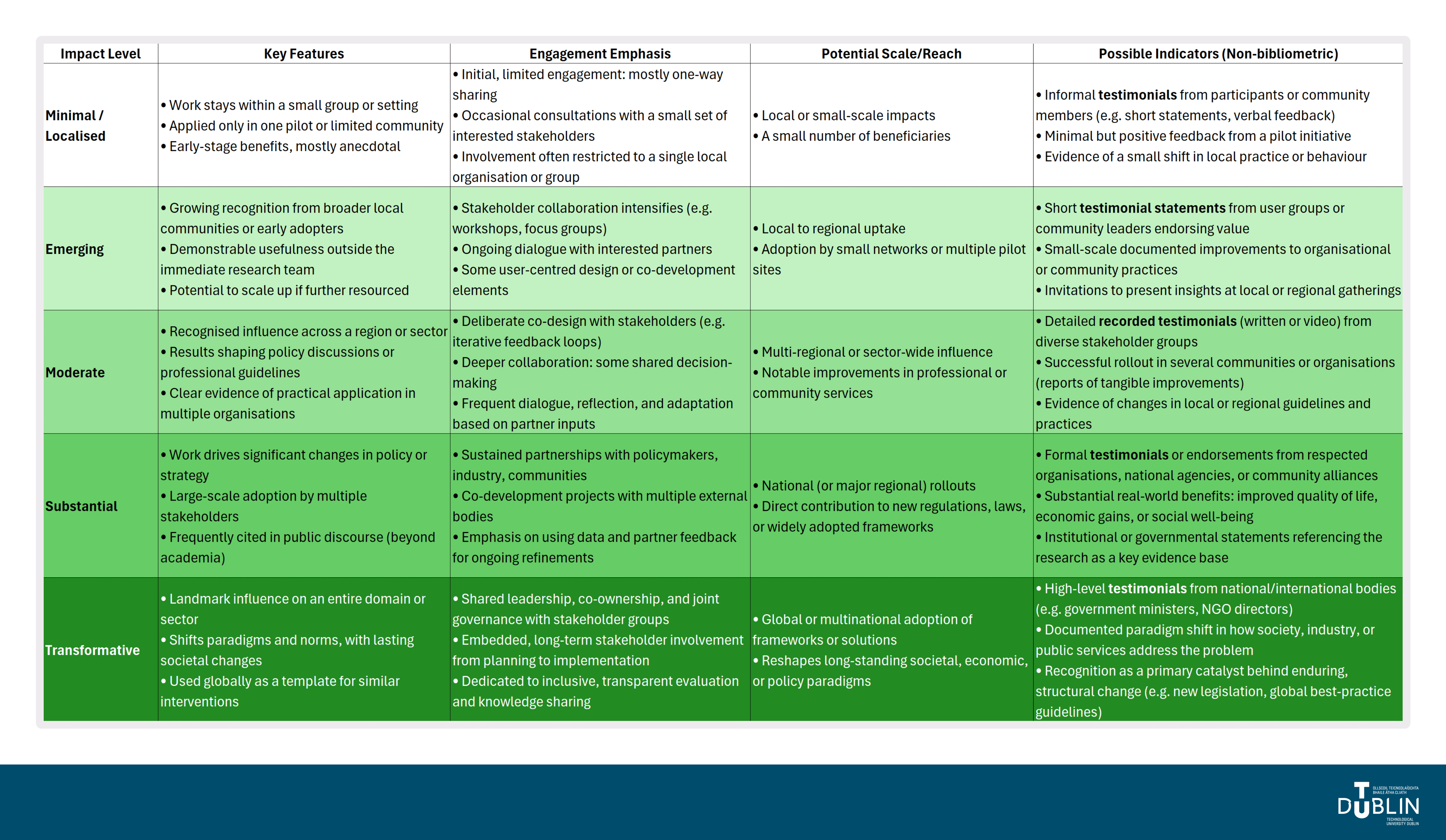
| Level | Typical reach | Engagement characteristics | Evidence examples |
|---|---|---|---|
| Minimal / Localised | Small groups or pilot settings | Limited engagement; exploratory trials | Anecdotal feedback; before–after measures; small usability tests |
| Emerging | Broader recognition in a unit or site | User-centred engagement; interest from early adopters | Letters of support; pilot uptake; downloads or sign-ups; workshop attendance |
| Moderate | Multiple organisations or a region | Co-designed initiatives; shared delivery | Adoption across teams; citations in guidance; service KPIs; training completion |
| Substantial | National systems or programmes | Formal partnerships; implementation at scale | Policy or practice change; independent evaluation; procurement or funding decisions |
| Transformative | International or global systems | Shared leadership; standard setting; sustained collaboration | Legislative or regulatory recognition; cross-border standards; longitudinal outcome data; SDG-aligned indicators |
This summary table gives you a quick way to locate your current level and identify the evidence to collect.

/filters:quality(80)/0x150:1920x450/prod01/tudublin-cdn-pxl/media/website/research/images/Header-Image-Lazers-FOCAS-2.png)